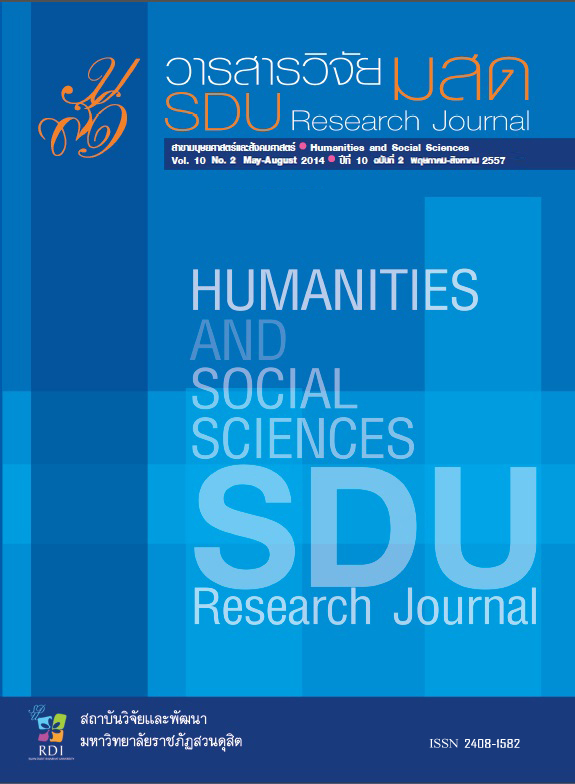รูปแบบการจัดการความรู้ในการพัฒนาประสิทธิผลการให้บริการประชาชนของเทศบาลตำบลถนนใหญ่ อำเภอเมืองลพบุรี จังหวัดลพบุรี
Keywords:
รูปแบบ, การจัดการความรู้, การพัฒนาประสิทธิผลการให้บริการประชาชนAbstract
บทคัดย่อ
การวิจัยเรื่อง รูปแบบการจัดการความรู้ในการพัฒนาประสิทธิผลการให้บริการประชาชนของเทศบาลตำบลถนนใหญ่ อำเภอเมืองลพบุรี จังหวัดลพบุรี มีวัตถุประสงค์ 1) เพื่อศึกษาถึงประสิทธิผลต่อการให้บริการประชาชนของเทศบาลตำบลถนนใหญ่ 2) เพื่อศึกษาปัจจัยที่ส่งผลต่อประสิทธิผลการให้บริการประชาชนของเทศบาลตำบลถนนใหญ่ 3) เพื่อศึกษาเปรียบเทียบความพึงพอใจต่อปัจจัยที่ส่งผลต่อประสิทธิผลการให้บริการประชาชนของเทศบาลตำบลถนนใหญ่ 4) เพื่อศึกษาความสัมพันธ์ระหว่างปัจจัยที่ส่งผลต่อประสิทธิผลการให้บริการประชาชนของเทศบาลตำบลถนนใหญ่กับประสิทธิผลการให้บริการประชาชนของเทศบาลตำบลถนนใหญ่ และ 5) เพื่อสร้างรูปแบบการพัฒนาประสิทธิผลการให้บริการประชาชนต่อไป ผู้วิจัยได้ดำเนินการวิจัยเชิงสำรวจกับกลุ่มตัวอย่างที่เป็นประชาชนผู้เข้ามาใช้บริการที่เทศบาลตำบลถนนใหญ่ จำนวน 356 คน โดยใช้แบบสอบถามในการเก็บรวบรวมข้อมูล ดำเนินวิธีวิจัยแบบประสม ได้แก่ การวิจัยเชิงปริมาณ และเชิงคุณภาพ เครื่องมือที่ใช้ในการวิจัย คือ สถิติ และ เครื่องมือการจัดการความรู้ ศึกษาค้นคว้าจากเอกสารตำราต่าง ๆ ที่เกี่ยวข้อง ตามแนวคิดทฤษฏีเกี่ยวกับประสิทธิผล แนวคิดเกี่ยวกับการบริหาร แนวคิดเกี่ยวกับการบริการ แนวคิดทฤษฏีเกี่ยวกับการจัดการความรู้ และแนวคิดเกี่ยวกับการบริหารราชการส่วนท้องถิ่น จากนั้นนำข้อมูลที่ได้มาวิเคราะห์ด้วย ค่าร้อยละ ค่าเฉลี่ย ส่วนเบี่ยงเบนมาตรฐาน การวิเคราะห์ความแปรปรวนทางเดียว สถิติทดสอบที และการวิเคราะห์ถดถอยพหุคูณ มีค่าความเชื่อมั่นเท่ากับ 0.93 สถิติที่ใช้ในการวิเคราะห์ข้อมูล คือ ค่าร้อยละ ค่าเฉลี่ย ( ) ส่วนเบี่ยงเบนมาตรฐาน (S.D.) การทดสอบที (t-test) การวิเคราะห์ความแปรปรวนทางเดียว (One-way ANOVA) การเปรียบเทียบค่าเฉลี่ยรายคู่ด้วยวิธีของเชฟเฟ่ (Scheffe’ Method) และ การวิเคราะห์หาค่าสัมประสิทธิสหสัมพันธ์ (Correlations) ด้วย Simple Regression สำหรับข้อมูลที่วิเคราะห์ได้นำมาจัดการสนทนากลุ่ม เพื่อสร้างรูปแบบการพัฒนาประสิทธิผลการให้บริการประชาชนต่อไป
ผลการวิจัยพบว่า
1.ปัจจัยด้านการพัฒนาประสิทธิผลการให้บริการของเทศบาลตำบลถนนใหญ่ พบว่า มีระดับการยอมรับระดับปานกลาง คือ (1) ด้านสถานที่และสภาพแวดล้อม (2) ด้านกระบวนการ/ ขั้นตอนการให้บริการ (3) ด้านการอำนวยความสะดวก ในส่วนของระดับความคาดหวังมีระดับความคาดหวังอยู่ในระดับมาก คือ (1) ด้านสถานที่และสภาพแวดล้อม (2) ด้านการอำนวยความสะดวก (3) ด้านกระบวนการ/ขั้นตอนการให้บริการ
2.ประสิทธิผลการให้บริการของเทศบาลตำบลถนนใหญ่ พบว่า มีระดับการยอมรับอยู่ในมาก คือ (1) ด้านความยุติธรรม (2) ด้านความใส่ใจในการบริการ (3) ด้านความเชี่ยวชาญในการให้บริการ ในส่วนระดับความคาดหวังอยู่ในระดับมาก คือ (1) ด้านความยุติธรรม (2) ด้านความเชี่ยวชาญในการให้บริการ (3) ด้านบริการข้อมูลป้อนกลับให้บริการตรงจุด
3.ผลการทดสอบสมมติฐาน พบว่า อายุ ระดับการศึกษา รายได้ต่อเดือน ความถี่ในการเข้ามาใช้บริการ และประเภทการเข้ามาใช้บริการ มีการยอมรับต่อปัจจัยด้านการพัฒนาประสิทธิผลการให้บริการในภาพรวมแตกต่างกัน ส่วนในด้านความคาดหวัง พบว่า เพศ ระดับการศึกษา ความถี่ในการเข้ามาใช้บริการ และประเภทการเข้ามาใช้บริการ มีความคาดหวังในปัจจัยด้านการพัฒนาประสิทธิผลการให้บริการในภาพรวมแตกต่างกัน
4.ผลการทดสอบสมมติฐาน พบว่า เพศอายุ สถานภาพของผู้มาติดต่อ รายได้ต่อเดือน และความถี่ในการเข้ามาใช้บริการ มีการยอมรับต่อประสิทธิผลการให้บริการต่างกัน ส่วนในด้านความคาดหวังต่อประสิทธิผลการให้บริการ เพศ สถานภาพของผู้มาติดต่อ อาชีพ ระดับการศึกษา และความถี่ในการเข้ามาใช้บริการมีการยอมรับต่างกัน
5.ปัจจัยด้านการพัฒนาประสิทธิผลการให้บริการมีความสัมพันธ์กับประสิทธิผลการให้บริการโดยพบว่า ระดับการยอมรับในปัจจัยด้านการพัฒนาประสิทธิผลการให้บริการมีความสัมพันธ์กับระดับการยอมรับในประสิทธิผลการให้บริการ และระดับความคาดหวังในปัจจัยด้านการพัฒนาประสิทธิผลการให้บริการ มีความสัมพันธ์กับระดับความคาดหวังในประสิทธิผลการให้บริการ โดยที่สามารถใช้เป็นตัวพยากรณ์ในการคาดคะเนประสิทธิผลการให้บริการ ได้อย่างมีนัยสำคัญทางสถิติที่ระดับ .05
จากข้อค้นพบในการวิจัยนี้ สามารถนำมาประมวลผลเป็นองค์ความรู้ หรือรูปแบบ (Model) ใหม่ ที่อ้างอิงมาจาก Peter M. Senge โดยมีลักษณะรูปแบบดังนี้
คำสำคัญ : รูปแบบ การจัดการความรู้ การพัฒนาประสิทธิผลการให้บริการประชาชน
Abstract
The purposes of this research study were : 1) to examine the effectiveness of providing services to people of Thanonyai Subdistrict Municipality, 2) to investigate factors affecting effectiveness of providing services to people of Thanonyai Subdistrict Municipality, 3) to compare people’s satisfaction on factors affecting effectiveness of providing services of Thanonyai Subdistrict Municipality, 4) to study correlations between factors affecting effectiveness of providing services to people and the effectiveness of providing services to people of Thanonyai Subdistrict Municipality and 5) to propose developmentalmodelt for effectiveness of service provision. The survey research was chosen in this study. For data collection, 356 people who received services from Thanonyai Subdistrict Municipality as subjects responded to the questionnaires. The quantitative and qualitative methods of study were used. Furthermore, regarding documentary study, the concepts and theories of effectiveness, administration, services, knowledge management and local administration were gathered. The data was analyzed by using percentage, mean, standard derivation, one-way ANOVA, t-test, multiple regression analysis (r = 0.93). The statistics used for data analysis were percentage, mean, standard derivation, t-test, one-way ANOVA, Scheffé’s method, and simple regression and correlation. The analyzed data was used in the focus group in order to design a model for developing an effectiveness of service provision.
The research findings revealed as follows:
1.The factor in development of effectiveness of providing services of Thanonyai Subdistrict Municipality, consisting of 5 aspects including service providers, procedure/steps in providing service, length of service, place and environment, and facilitation, were at the moderate levels in general. Having considered each of the aspects, respondents had moderate levels of satisfaction in aspects of place and environment, procedure/steps in providing service, facilitation, length of service, and service providers respectively.
Moreover, level of overall expectation was high. Considering each of the aspects, a high level was found in aspects of place and environment, followed by facilitation and procedure/steps in providing service whereas moderate level of expectation was found in length of service, and service providers respectively.
2.Regarding the effectiveness of providing services of Thanonyai Subdistrict Municipality, there was a moderate level of overall satisfaction in all 4 aspects including service care, service expertise, service on giving right feedback, and fairness respectively. Considering each aspect, high levels were shown in fairness, followed by service care, service expertise, and service on giving right feedback respectively.
Overall, high level of expectation was revealed. When considering each aspect, high levels in aspects of fairness, service expertise, and service on giving right feedback were remarked respectively whereas service care was at a moderate level.
3.The results of a hypothesis testing showed that there were no significant differences between respondents’ gender, marital status or occupation and development of effectiveness of providing services. On the contrary, there were significant differences between age, education, monthly income, frequency of receiving services or types of services and development of effectiveness of providing services. With age, occupation, and monthly income, respondents’ expectations for development of effectiveness of providing services, classified by age, were not different significantly. However, concerning gender, education, frequency of receiving services, and types of services, their overall expectations for development of effectiveness of providing services, classified by marital status, were significant differences.
4.The test results indicated that significant differences among gender, age, marital status, monthly income, and frequency of receiving services influenced satisfaction of effectiveness of providing services whereas no significant difference among occupation, education, and types of services. According to expectations for effectiveness of providing services, gender, marital status, occupation, education, and frequency of receiving services were significantly different whereas no different expectations in age, monthly income, and types of services.
5.There was a relationship between the factor in development of effectiveness of providing services and effectiveness of providing services with the level of significance at .05 (61.8%). The levels of expectations for the factor in development of effectiveness of providing services were positively correlated with the levels of effectiveness of providing services with a significance level of .05 (71.5%).
The implications of the research findings must be viewed in lights of knowledge or new model for learning organization (quoted from Senge) leading to design developmental format for effectiveness of service provision. By which model.
Keywords: development, effectiveness, services








